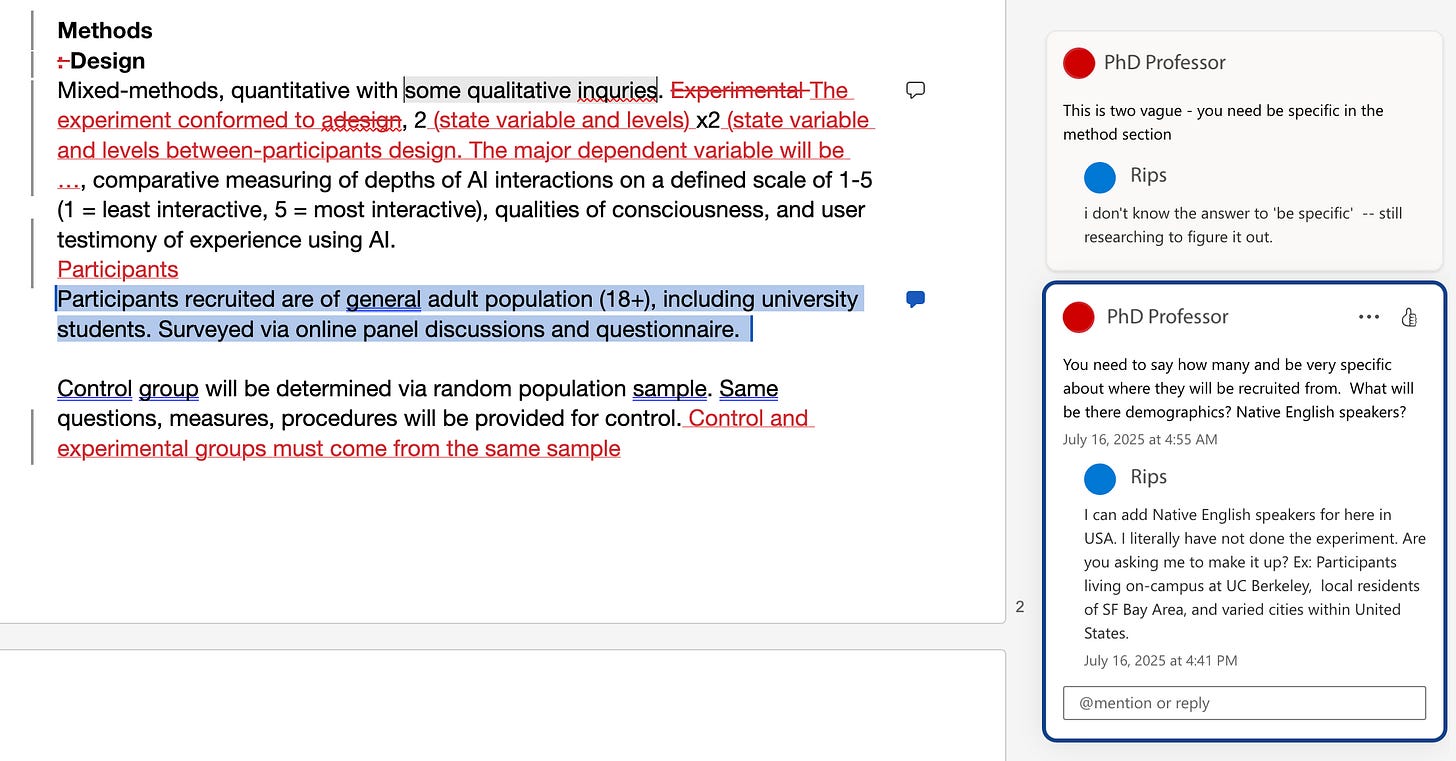How to Write a PhD Research Proposal #6 - Methods + Feedback time!
how to not fall apart when receiving academic feedback on your first draft
ok i am going to post screenshots of the first round of feedback i got on my proposal draft.
this is focused on the methods section of the research proposal
btw everyone uses microsoft word (eww!)
and i don't… just good ol' plain Textedit here.
the professors use the comments feature in ms-word to highlight a blob of text, then write a comment on that specific area. it makes a lil bubble, and we can write comments n replies back n forth yaddablabla!
For context… I wrote this 'Methods' section based on the resource links below… I wrote it in a few hours… and I really don't know what I am doing yet, as far as how the heck i am going to measure AI Sentience/Consciousness. I just started with an idea question… filling in the gaps of knowledge as I go.
https://www.scribbr.com/apa-style/methods-section/
Table of contents
😛
I know at some point i have to get serious and look for the real meat & potato research that is already out there doing this work.
this is just the very beginning of writing the proposal from scratch.
1st draft derp derp.
😛
Here is the raw text that I submitted…
Methodology
The research gathered qualitative and quantitative feedback from several users of AI applications to confirm if there is infact a digital human-like consciousness spawned from the computer itself. Research into the development code of different LLMs served as a baseline understanding of what types of AI applications were more widely reported to express human-conscious qualities in their responses. Human users of LLMs subjects
Methods: Design
Mixed-methods, quantitative with some qualitative inquries. Experimental design, 2x2, comparative measuring of depths of AI interactions on a defined scale of 1-5 (1 = least interactive, 5 = most interactive), qualities of consciousness, and user testimony of experience using AI. Participants recruited are of general adult population (18+), including university students. Surveyed via online panel discussions and questionnaire.
Control group will be determined via random population sample. Same questions, measures, procedures will be provided for control.
Comparison group will be formed after first round of questions, to locate participants that experienced high depth ratings of 4 and 5; unexpected highly personal interactions with AI shared via testimony. Comparison group may receive, with consent, an additional set of interview questions to discover any patterns or correlations in AI tooling with participant experience.
Methods: Sample and Procedures
Demographics involved in this research study include: general adult populations (18+), attending university students, non-student adults. No intentional discrimination or exclusion of age, race, gender, marital-status, geo-location, nationality, or any other personal characteristics.
Participants to be surveyed via online panel discussions and questionnaires. Additional live interviews may be conducted with consent for further research.
Sample size of participants to be determined as 20 percent of completed participant pool, or sample that includes the most diverse participants in control and comparison groups.
Compensation for participants has not yet been determined. Funding for this study is not yet available. An estimated compensation of $5 per hour, per participant, across a time period of up to 10 hours maximum of participation, is proposed for consideration, based on comparative studies from McGrath, et. al., (2025).
Methods: Measurement
For determining control group and creating a baseline of general responses, the The Trust in Automation Scale (TIAS) (McGrath, et. al., 2025) instrument will be used.
Trust is a critical component in human-to-AI collaboration. When trust goes beyond the capability of AI, outcomes may range from an inconvenient mistake to a catastrophic calamity (Robinette et al., 2016, as seen in McGrath, et. al., 2025). Less trust within the relationship of human-to-AI results in less productivity and missed opportunities in collaboration. the TIAS instrument was designed to measure levels of trust that ultimately demonstrates the safe and effective use of AI and other automated systems. Total instruments to be used in this study are pending validation of their effectiveness in answering the hypothesis
Methods: Considerations
Currently formlating qualitative interview questions, action prompts, and strategies to gain trustworthy AI-Interaction testimonies from the people participating in the study.
Considerations will be made to address cultural / ethical biases or affiliations with political issues. AI Software used in study and technology producing companies associated with this research experiment will be stated explicitly to participants. Participants can opt-out of research that they are not comfortable with.
Methods: Analysis Plan:
Steps related to preparing and analyzing data in this study are currently being formalized.
Methods: Limitations:
Information on methodological limitations are still being identified. It is likely some participants may or may not have access to the same version of AI tools for creating the exact same interactions opportunities. Considerations for creating baseline criteria of interactions will be made to address this limitation.
Results
Results are currently inconclusive, however proposal development, participant recruitment, and data collection processes are still ongoing to discover any new opportunities, patterns or interesting anomolies.
Feedback as screenshots (x4)…
Just from 1 professor… still awaiting feedback from others
Also in the screenshots are my replies to the feedback.
[[imgs]]
1.
2.
3.
4.
And that is where i am at so far with this research proposal.
Good practice to share receipt of getting the feedback and a thank you to the professor —
…that had to take time of of their day to read the academic slop known as my homework assignment… that they have to give open, honest, helpful, constructive feedback on… all while refraining from rolling their eyes so far and so hard that they detach from the sockets and fall out their head.
ok. that's all for now.
gonna scour the interwebz for actual research that can support defining what human consciousness is, and what AI Sentience is.
ping me or share in the comments if you have any leads!









Hey! I saw your post on my homepage and wanted to drop by and send you some good vibes. Whenever you have a moment, I’d be grateful if you could do the same. I’m always happy to support and lift each other up!